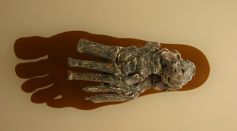Tags: Evolution

Cosmic Expansion: Is the Universe Expanding by Colliding to Baby Parallel Universes?

Evolution of Human Locomotion: 6-Million-Year-Old Fossil Reveals History of Bipedal Stance
Shallow Soda Lakes Could Be Strong Candidate for the Emergence of Life on Earth, Study Reveals

Young, Close Earth-Sized Hot Exoplanet Offers Unique Insights into Planetary Evolution

Prehistoric Primates Likely Lived in Pairs; How Did It Affect the Evolution of Social Organizations in Humans?
Human Evolution: Natural Selection Is Still at Play, Evolutionary Biomechanist Says

1,000-Year-Old Chicken DNA Reveals Ancient Origin of Marek’s Disease, Chicken Virus Evolves to Become More Deadly
![Natural Aging Helps Evolution If There's Selection For Senescence [Study]](https://d.sciencetimes.com/en/full/50911/natural-aging-helps-evolution-if-theres-selection-senescence-study.jpg?w=237&h=131&f=af790fd37518832e57c09baa0d93c035)
Natural Aging Helps Evolution if There’s Selection for Senescence [Study]

Fermentation May Have Driven Evolution of Ancient Humans; How Did Dietary Changes Allow Our Brain to Grow Larger?
Male Sea Snakes Evolve To Be Smaller With Bigger Eyes Than Female Counterparts [Study]
30-Million-Year-Old Fossils Shed Light on How Whales, Dolphins’ Echolocation Evolves

Discovery of 100 Eroded Dwarf Galaxies Unravels Mystery Behind Ultra-Compact Cosmic Evolution

Ancient Spiral Galaxy 'Ceers-2112' Challenges Theories on Galactic Evolution, Resembling Milky Way in Its Youth

407-Million-Year-Old Fossil Fish Reveal the Origin of Shoulders in Vertebrates

Proteins in Prehistoric Skeletons Unlock the Secrets of Mankind’s Family Tree, Provides Insight Into Human Evolution

130-Million-Year-Old Jewel Wasps Discovered in Cretaceous Amber Reveal Early Evolution of Parasitoid Insects

FLAMINGO Simulations: Unveiling Cosmic Secrets To Illuminate Universe's Evolution and Expansion
170-Million-Year-Old Fossils Reveal Oldest Mega-Predatory Pliosaur, Offer Insight Into Prehistoric Marine Evolution
Rare Superdeep Diamonds Reveal Secrets of Ancient Supercontinent Formation and Movement
Bedbugs Resurgence Due to Evolution, Climate Change? Insects Are Becoming Resistant to Pesticide
Most Popular

Largest Known Volcanic Aquifer Discovered Beneath Oregon's Cascades

New 'Supergiant' Sea Bug Found in South China Sea, Named After Darth Vader

Mediterranean Sea Was Refilled by a Catastrophic Flood Millions of Years Ago

Mysterious Cosmic Waves That Sound Like Birds Detected in Unexpected Space Region




